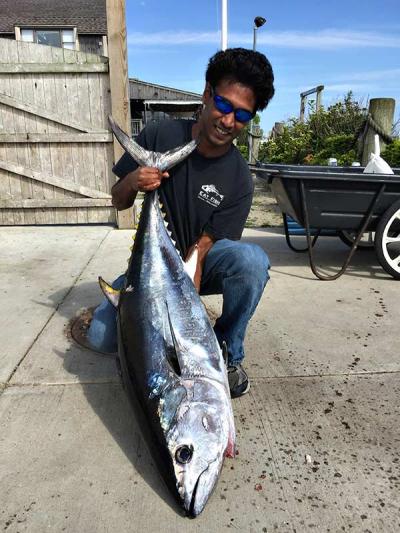An Eye on the Shark’s Eye

This season’s no-kill shark fishing tournament is named the Carl Darenberg Memorial Shark’s Eye Tournament after the late owner of the Montauk Marine Basin who broke with precedent by maintaining the Marine Basin’s exciting tradition of shark tournaments while sparing the lives of sharks.
Darenberg also championed the use of non-stainless-steel circle hooks, a type of hook that lodges in a fish’s jaw rather than in its gut and which corrodes over time to eventually free caught-and-released sharks from the hooks and any attached line. The use of circle hooks to catch sharks is now the law in New York State, and there is an ongoing effort to make it the law of the land.
No-kill tournaments lack the spectacle — some might say, the medieval spectacle — of dead sharks being hauled high on marina gibbets to be ogled, ooed, and awed at before being drawn and quartered in name of science.
In this respect, no-kill tournaments have leaped centuries from an age when people gathered to witness bear-baiting and gory death to one in which satellites circling the earth permit the tracking of fish that have special tags placed on them before they are set free.
This does not satisfy everyone, because the primitive lure of bloody spectacle is made more alluring by the equally primitive urge to gamble on bloody spectacle — cockfights writ large. Cash prizes for the biggest sharks in kill tournaments range into the hundreds of thousands of dollars.
Shark tournaments exploded in popularity after the movie “Jaws,” based on Peter Benchley’s book of the same name, hit the screens in 1975. Benchley had created a bugbear that resurrected the fear of being eaten alive that for most of us had been replaced by fear of bug bites, sunburn, and pollen.
Peter Benchley’s book was set, not in a village called Amity on an island as in the movie. It was set in Amagansett just down the road from Montauk, a place the author departed from on a number of occasions aboard the Cricket II, the late Capt. Frank Mundus’s infamous shark-fishing charter boat.
Starting in the late ’50s, Captain Mundus, Montauk’s “Monster Man,” dragged big sharks back to the harbor, some of them too big to hoist aloft, and thus bigger still in the public’s imagination. Although not one to publicly bite the hand that fed him, Mundus grew to despise the monster, in the form of shark tournaments, that he himself — through Benchley’s experiences aboard Cricket — had helped create. They were amateur hour in his eyes, and wasteful.
Last summer, Wendy Benchley, Peter Benchley’s widow, fished in the Montauk Marine Basin’s Shark’s Eye tournament. She caught a mako she named Cate Ells. The shark was fitted with a satellite tag and its wanderings were tracked on computers via the Ocearch Web site for months until the shark became a “confirmed kill” a week ago.
Today, none of the 10 satellite-tagged sharks — 6 makos, 2 tigers, and 2 blues — caught during last summer’s Shark’s Eye tournament are still pinging their locations. They have either been caught, died naturally, or their tags have ceased working for some technical reason. Perhaps they have been beamed up to the satellites and now circle the earth showering us with green vibes.
This year’s Shark’s Eye tournament will be held from the Montauk Marine Basin on July 18 and 19. Five satellite tags have been made available. One will be placed on a shark to be named Carl Darenberg after the tournament’s founder. Three others will be named by the anglers that catch them, and the fifth grade class at the Sag Harbor School has dibs on a tag to be fitted on a shark the students have already named Seamore.
The Oceans Institute of the Montauk Lighthouse Museum, a.k.a. the Montauk Surf Museum, has asked that a sixth tag be made available so that its shark can be tracked on a video screen located in the museum, and in real time. Organizers of the tournament inform me that more boats, and more observers (those who identify and virtually weigh caught sharks via still and video cameras) are needed. It’s important to support this tournament and spread the concept to other areas. Needless killing should be a thing of the past.
In other fishing news, striped bass surf fishermen using clam baits have been doing well along south-facing beaches. Porgies continue to abound in Gardiner’s Bay, and though scattered by the recent blow, bluefish are beginning to school en masse.
Migrating bluefin tuna are said to be in range of Montauk, as close as eight miles offshore.
